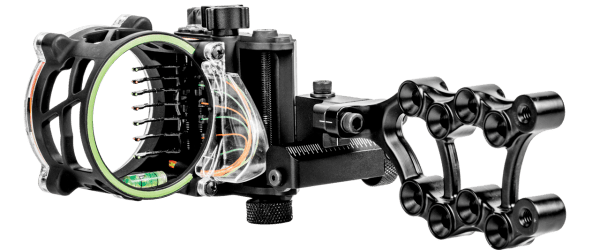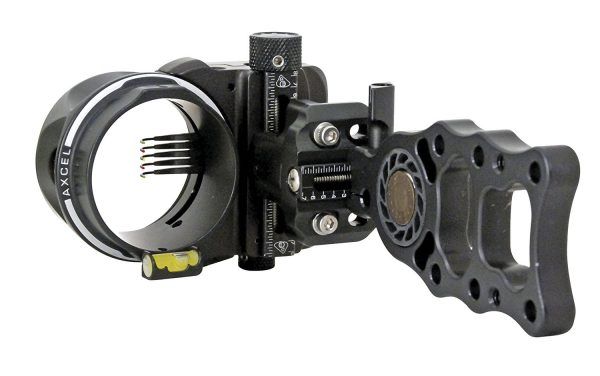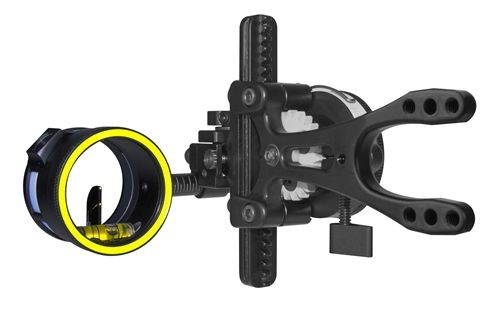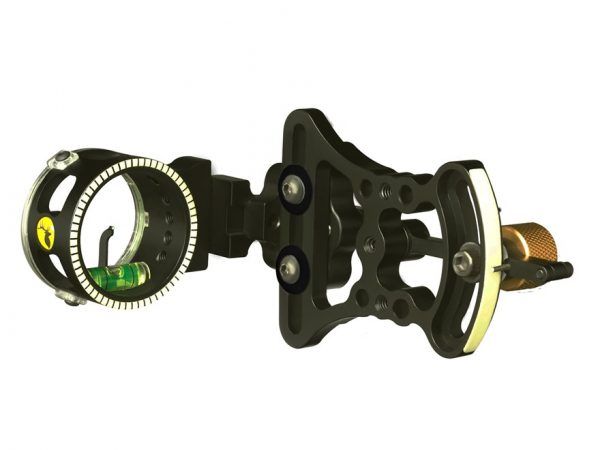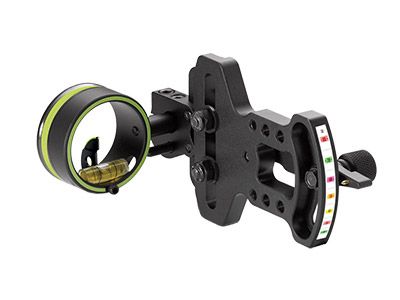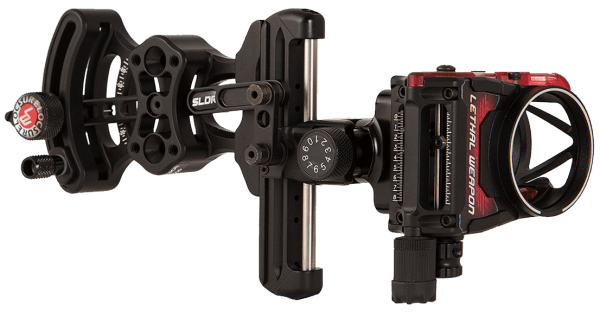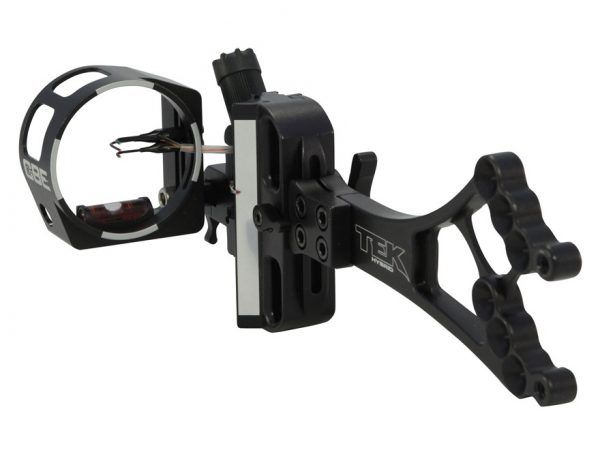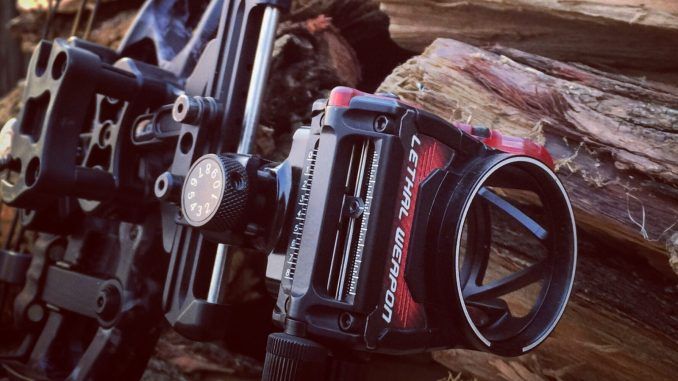
When you are new to archery and bowhunting, the various options on sights seem to be a bit overwhelming (one of the reasons I like the idea of the RAK-kit on the Diamond bows!) So what we have here is a short article to help you as a new bowhunter make some decisions on choosing a bow sight.
First of, I have to tell you that regardless of what you decide, some guy at your local range or watering hole will tell you that you made a mistake… Smile wave and enjoy your archery. Its going to happen, enjoy the moment and hear in your head “…I told you so!”
But on to the nitty gritty.
Every manufacturer tries to do something special on their sights to make it more “betterrer” than the next one on the shelf. some things are great, some are gimmicks but essentially, every sight comes down to the exact same concept of use. A system where, when the bow is aligned correctly, the arrow will hit where the dot or pin was on the target.
All the variations will happen in one of three basic configurations: multi-pin vs single pin vs over/under. You need to decide which one makes more sense to you as a person before you buy, and that is what will give you peace of mind and really narrow down your search.
Multi-pin sights: 3-pin, 5-pin or 7-pin
These you will most likely see on the bulk of the hunting bows out there. It’s a sight housing with multiple pins to designate the different distances. The topmost pin is usually set for 10-20yds, second pin for 30yds, 3rd pin for 40yds, and so on and so forth.
The logic behind it is simple. If you need to stalk and the animal can be on any distance, then once you have ranged, and or guessed the distance, you draw up and shoot. Should the animal move, you can simply choose another pin, without letting down and resetting your sight. Seems like a good plan overall, and many people will happily work with that.
However… some people simply can’t keep the peep and the housing aligned as they switch between pins, alway slowly floating the pin to the centre of the peep, causing a parallax error and possible high or low shot (this can be greatly reduced with a kisser button, but the kisser button can, again, be negated when you shoot with a face mask… decisions, decisions …)
The advantage of multiple pins is in gap shooting. When the animal is an odd distance, say 37yds, then you will take your 40yd pin and aim a bit low. How low? Well, you have a 30yd pin to tell you what’s what. If you go below the halfway distance between the 40yd pin and 30yd pin, then you know you have gone too low, and might be in trouble. So you have a manual range indicator and “warning” system in place.
The biggest error I see, however, when shooting with multiple pins, is that in the moment, under pressure, with buck fever coursing through your body… you aim with the wrong pin. You choose the third pin for your 30yd shot… except, the 3rd pin is usually the 40yd pin. So you hit high and walk far, or miss altogether (better for your animal, worse for your ego)
Pros
- No need to reset the sight or let down if the distance to target changes (decide on a different animal to shoot, or the animal you have chosen, walks further or closer
- Adjusting for off pin distances is more accurate – Manual Warning system
- Once set, they remain accurate.
- No moving parts – very small failure rate
- Even really cheap ones are accurate
Cons
- Possibility for parallax errors.
- Shooting with the wrong pin
Single Pin sights
Essentially, these types of bow sights are just as the name implies: a sight with a single pin to aim with.
These sights solves a lot of problems of the multi-pin sights, and perfect for the archer that wants to have his or her bow set exactly to the correct distance. Chances of a parallax error is almost zero, and the chance to pick the wrong pin is zero… hey, there is only one to choose from! There is a reason why competitive archers almost always compete with single dot or single pin sights – they are extremely accurate down to the yard!
The sights come in different configurations, like a lever action, a sliding housing or a rotational geared knob. All doing the same job: it moves the whole housing up and down. Generally you would have a sight tape with distance markers (each on is different, according to your bow specs and arrow weights)
We already know what the good things are about them. What are the bad things? Well, they have moving parts, which means they do get gunked up in bad weather, wind and dust, so you need to care for them and clean them up every now and again, and also, the moving parts can work loose or break.
The worst part is probably that if you are at full draw, and the animal moves, you need to either guess where to adjust your aim to (high or low) or let down, re-range, and re-adjust the sight, then draw up again. increasing the chances of making a noise or a movement that the animals can see or hear and get spooked.
It is suggested to get in a habit of always resetting your sight to a specific distance when stalking… that way, you will always know your sight is right for a specific distance as you come into a shot.
Pros
- No parallax errors
- No “wrong pin” mistakes
- Extremely accurate on all distances, not just 10yd increments
Cons
- Moving parts can work loose/break
- Gap shooting is a guess
- Need more time to set or re-set the sight before taking a shot
- There are rarely “cheap” ones worth getting
- forgetting to set the sight can be disastrous
Over/Under or Floating Pin sights
The sight that is probably the “best of both worlds” for bow sights. Essentially, an over under sight works like a single pin sight, that moves up and down according to a sight tape measurement, but it also has 2 or more extra pins above and below the single pin that is set at 10yd increments away from centre.
What do you get for that? A centre pin that is exact distance away, and a pin above that is 10yds shorter, and a pin below that is ten yards longer. So, set your sight on the exact distance, and draw up, if the animal moves closer, simply estimate the gap, and adjust, knowing that you might have gone too far if you reach the next pin – all the advantages of a multi-pin sight and gap shooting. Not confident in the new distance, simply let-down, re-range and reset to exact – All the advantages of a single pin sight.
So why aren’t all sights made this way? Well, it means a lot more material on the sight (heavier), and a lot more parts that can possibly fail. And because of the extra engineering and parts… they tend to be much more expensive.
Not everybody shoot these sights in an over/under configuration (and some sights, like the TrophyTaker Option6 is made specifically with a floating pin configuration. That means that your 5 pin over/under sight (for example), doesn’t use the middle pin as exact, but the last pin as a 60yd floating pin. So when the sight is set to 60, all the pins will be in a standard 5-pin configuration from 20yds to 60yds, but should you need extra distance, the sight tape begins at 60 yds and the last pin can be set at exact longer distances.
If you shoot like this, It’s EXTREMELY IMPORTANT to remember to reset your sight, otherwise your pins will all be in the wrong positions!
Pros
- Shoot it like a single pin or multipin sight
- Can be an over/under or Floating pin configuration
- Tends to be very high quality builds
Cons
- Heavier than most sights
- More parts that can fail
- Forgetting to set the sight can be disastrous
- Price
After deciding your flavour, from there its simply a matter of choosing material, extra features, and head sizes (and possibly pin sizes)
Plastic, Carbon or Aluminium
Plastic is cheap, but wears out fairly quickly, especially if you make a lot of adjustments. Carbon is light and great for stalking, but pushes the price up no end, and Aluminium is heavier than both, more affordable than carbon and longer wearing than plastic, but it is brittle – so check it for bends or cracks if it took a heavy nock!
Head Size
The head size needs to match your peep size. Not all sights comes in different head versions, or allows interchangeable heads, but its not the end of the world if you can set your peep size. Generally, we like a slightly larger head because it allows us a bit more visual reference to see another animal about to walk into a shot, for instance.
A smaller housing tends to focus your attention more on the shot at hand, not getting distracted by other movements, but the smaller peep that goes with it might reduce you light hitting the eye. If unsure, go medium size and work from there.
Pin Size
The pin size is also something to think about. A size 20 pin (0.019”) is nice and bright and transfers a lot of light to the tip of the pin, making them very visual, but all that light makes the pin look bigger than it really is, and on smaller target areas, you might end up covering up the intended target area. This causes some people to move the pin up and down or left and right to “check” if they are still on target.
If you start on a size 10 (0.010) the pin is very small and very exact, but very small, and did I mention small? The small, fine fibre also transfers only about half the light of a size 20 fibre, so much much less light to create the dot you are aiming with – be sure to get a sight light if you will be shooting where the sun don’t shine! (like from a dark hide!)
Extra Features
All the sights will have some extra feature to try and sway you to rather buy that sight instead of this sight. Most of them are nice-to-haves, but not required. That doesn’t mean it’s useless though, so think about it a bit before you decide.
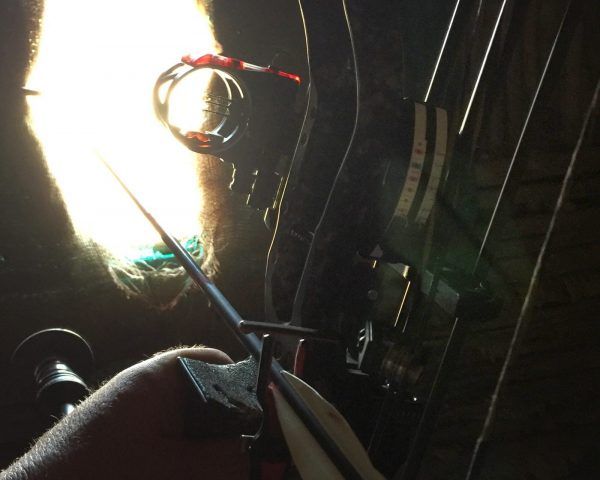 Some sights has interchangeable sight tapes if your bow needs to respond differently or have different arrows for different scenarios. For instance, my Sure-loc Lethal Weapon RED SLDR is an over/under sight with dual sight tapes. Why do I like it? For most of the season I shoot a 474gr arrow on a Bowtech (which has a comfort or performance setting on the modules) so the one sight tape works great for that setup: 474gr arrow on Comfort. But should I need to hunt big game, I can switch to my 760gr heavy arrows, and switch the bow to Performance on the module and use the second sight tape. I can literally swop back to my old settings in the hide and swop arrows and have no problem going back to my old sight settings.
Some sights has interchangeable sight tapes if your bow needs to respond differently or have different arrows for different scenarios. For instance, my Sure-loc Lethal Weapon RED SLDR is an over/under sight with dual sight tapes. Why do I like it? For most of the season I shoot a 474gr arrow on a Bowtech (which has a comfort or performance setting on the modules) so the one sight tape works great for that setup: 474gr arrow on Comfort. But should I need to hunt big game, I can switch to my 760gr heavy arrows, and switch the bow to Performance on the module and use the second sight tape. I can literally swop back to my old settings in the hide and swop arrows and have no problem going back to my old sight settings.
Is this a dealbreaker? absolutely not… but it sure is handy!
Conclusion
I have found that most people match their sight preference to their personalities. But I have also found that no matter what sight you choose… with a bit of practice, you will get comfortable with it, get accurate with it, and then be happy with it… so don’t sweat it if you are not 100% certain when you buy.

